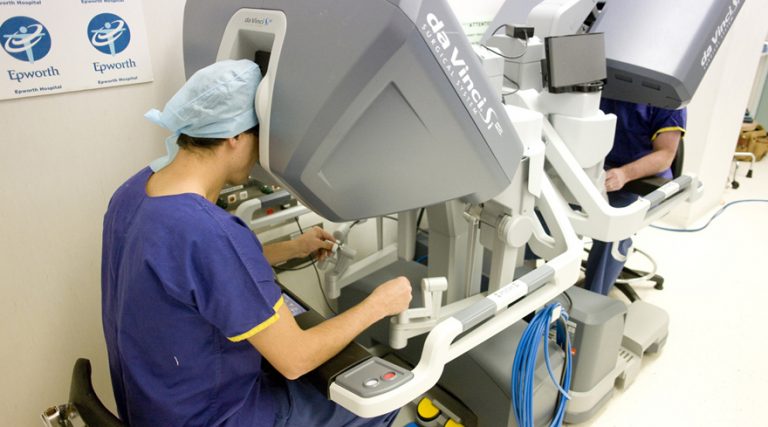Earlier this year, a former U.S. Air Force captain took his first steps in 27 years. Paralyzed from a fall in 1991 that broke five vertebrae, Dean Juntunen had been getting around by wheelchair. Now he’s learning to walk again with a wearable robotic exoskeleton at the Milwaukee VA Medical Center’s Spinal Cord Injury Center.
“Just standing talking to you is interesting,” Juntunen was quoted as saying in a blog post by the U.S. Department of Veterans Affairs. “I had not gone from a sitting position to a standing position in 27 years. I got injured in ’91, so just that in itself is fun. I like just standing up and moving around.”
Stories like Juntunen’s are becoming common as robotics and artificial intelligence (AI) are changing medicine and healthcare. While the big story in this field has been surgical robots—Intuitive Surgical Inc.’s da Vinci system has been used in more than six million surgeries around the world over the past 20 years—these technologies are transforming everything from imaging and diagnosis to rehabilitation and drug discovery.

ARISE, ROBOTS
Earlier this year, surgeons at Tokyo Women’s Medical University–Waseda University Joint Institute for Advanced Biomedical Sciences (TWIns) completed a groundbreaking brain surgery to treat a nerve disorder called essential tremor, a common cause of shaky limbs. The operation featured the latest version of the center’s Smart Cyber Operating Theater (SCOT), or Hyper SCOT. With looks that evoke the sickbay aboard the USS Enterprise-D, the starship at the center of the television series "Star Trek: The Next Generation," Hyper SCOT blends AI and robotics tools to maximize surgical results.
During surgery, brain tissue looks like reddish-pink Jell-O, and it’s not easy to distinguish areas of the brain that should be treated. Hyper SCOT can provide brain surgeons with guidance about where incisions should be made, as well as surgical prognoses in near-real time.
It also gives surgeons access to magnetic resonance imaging (MRI) during the operation. A robotic system moves patients from the operating area to an MRI scanner nearby to obtain high-resolution brain imagery. Until now, MRI has only been available before or after surgery, but having it during a procedure could significantly improve outcomes. Meanwhile, Hyper SCOT also collates data from all connected devices in and around the operating room, so doctors can make best-informed decisions.
“If we have many kinds of information, we need some kind of strategy desk, like Mission Control at NASA,” SCOT project leader Yoshihiro Muragaki, a professor at Tokyo Women’s Medical University’s Institute of Advanced Biomedical Engineering and Science, recently told Forbes. “Our moonshot is to make new eyes, brains, and hands for surgeons. With SCOT, we can perform precision-guided therapy.”
While exoskeletons and automation-assisted surgeries are benefitting patients, in other cases robotic technologies are becoming part of the human body, turning their recipients into cyborgs. Earlier this year, 14-year-old Giovanna Dubuc of North Carolina, born without part of her right arm, was fitted with a Hero Arm, a 3D-printed prosthetic arm that can read muscle signals and transform them into robotic movements. With her Luke Skywalker-style bionic hand, Dubuc can pick up small objects, make “heart” signs with her robotic fingers, and steer her bicycle. The prosthetic has changed her life, and she’s not alone. More than three million people may be living with limb loss in the United States by 2050, by which time bionic prostheses surgeries to link the mind to artificial limbs may be routine.
ACCELERATED MEDICINE
If progress in AI over the next 30 years is anything like the past 30, it will have a major impact on many areas of society. In the 1980s, some of the earliest probabilistic translation programs were being developed, and now Google Translate, a free app in many smartphones, translates more than 143 billion words every day in more than 100 languages.
Using AI in healthcare, though, is complex—and the margin for error is small. To accelerate the uptake of AI in medicine, the US Food and Drug Administration established in 2017 a pre-certification process to enable digital health companies to bring AI solutions to market in a more streamlined manner than was previously possible.
One of the fields drawing a lot of attention for AI applications is medical imaging—the source of 90 percent of all healthcare data. Like the MRI scans in Hyper SCOT surgeries, imaging technologies can provide physicians with important insights about a condition. Aided by AI, they can become exponentially more powerful. GE Healthcare sees the AI healthcare market hitting $6.6 billion by 2021 and is trying to maximize its share of that with Edison, an AI platform that can draw upon data from millions of connected imaging devices.
One example of how Edison is being used comes from the University of California, San Francisco Medical Center, where doctors harnessed the platform to automatically and accurately detect signs of pneumothorax, a potentially fatal lung condition, from chest X-rays. The system can immediately alert physicians to signs of trouble, potentially saving lives. Compare this with the conventional process, in which up to eight hours may pass before doctors get around to looking at the images. GE Healthcare Japan showed off the application, known as Critical Care Suite, at a conference in Yokohama in April.
Other new tools the company announced include applications for MRI brain scans and deep-learning image reconstruction in computed tomography (CT) scans. The company says AI can help address radiologist shortages in Japan at a time when the population is aging and the burden on healthcare services is growing.
“In the past few decades, scientists and engineers—along with medical practitioners—have built increasingly intelligent computer systems that aid not only diagnosis but also treatment procedures,” Nozomu Uetake, Japan Research Leader, GE Healthcare Japan, told The ACCJ Journal. “We intend to increase the accuracy and efficiency, in terms of quantifiable and repeatable diagnostic accuracy, throughput, improved workflows, improved patient outcomes, etc., by injecting AI technologies based on Big Data at each of the healthcare steps.”

MACHINE PHARMACISTS
Edison isn’t the only AI platform changing healthcare. The pharmaceutical industry is trying to leverage tools such as machine learning to cut the time and expense of developing new drugs. Current processes can cost more than $2 billion, take more than 10 years to bring a medicine to market, and fail during development nine times out of 10.
One area of development is molecule design. The Machine Learning for Pharmaceutical Discovery and Synthesis Consortium brings together the Massachusetts Institute of Technology and 13 of the top pharma companies:
- Amgen Inc.
- AstraZeneca
- BASF SE
- Bayer AG
- Eli Lilly and Company
- GlaxoSmithKline plc
- Janssen Pharmaceutica
- Leo Pharma Inc.
- Merck & Co., Inc.
- Novartis AG
- Pfizer Inc.
- Sunovion Pharmaceuticals Inc.
- Wuxi AppTec
Researchers in this collaboration are using machine learning in an attempt to fully automate the process of designing new molecules for pharmaceuticals. Cancer is another promising field for AI due to its prevalence and the extremely complex interplay between the disease and the human immune system. Pfizer, for instance, is using IBM Watson to power its hunt for immuno-oncology agents.
“In the pharmaceutical industry, we see AI increasingly used in three key areas—modeling to predict treatment outcomes, drug discovery and design, and data processing,” says John W. Carlson III, manager for government affairs at AbbVie Japan and chair of the American Chamber of Commerce in Japan Healthcare Committee. “Each has the potential to significantly improve industry productivity with the potential to usher in an entirely new generation of personalized medicines.”
Spun out of Abbott Laboratories in 2013, AbbVie is a biopharmaceutical company focused on creating new drugs in clinical fields such as oncology, neuroscience, and immunology. While the company has been secretive about how it’s harnessing AI, it has been using robots to help handle compounds screened for use in potential new drugs. AbbVie is also in partnerships with Alphabet Inc.’s Calico—itself dedicated to extending human life, to develop new therapies for age-related conditions such as cancer—and Atomwise Inc., which is designing new drugs through convolutional neural networks, a common AI tool.
In Japan, AbbVie has been implementing robotic process automation software in the generation of internal reports and about 30 other simple, time-consuming processes—equivalent to some 3,000 person-hours of work—according to IT director Yoichiro Ishikawa.
“There are huge opportunities right in front of us in leveraging AI and other automation technologies to improve the lives of patients, enhancing research and business productivity by simplifying processes and better utilizing limited resources,” said James Feliciano, president of AbbVie Japan and co-chair of the ACCJ CEO Forum. “Amidst Japan’s tight labor market, the application of such automation technologies will likely be a key factor in weeding out the winners and losers of a new generation.”
Custom Media publishes The ACCJ Journal for the American Chamber of Commerce in Japan.
- External Link
- https://journal.accj.or.jp/robo-doc/
 Take our user survey and make your voice heard.
Take our user survey and make your voice heard.














2 Comments
Login to comment
Nobnaga
i hope this artificial intelligence will help them to find cure to many problems i really wish they can do that in short time
kurisupisu
There is no such a computer that is artificially intelligent at present-it is incorrect to use such a term.